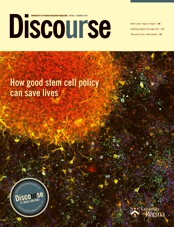U of R doctoral student Emily Winters examines the use of cannabis in long-term care homes across Canada.

It’s been over five years since Canada—the first among G7 and G20 nations—legalized and regulated the sale and distribution of cannabis, sanctioning it for medicinal and recreational use. Since then, thousands of retail stores have popped up across all ten provinces and territories. Millions of Canadians consume the drug, in its various forms, every year.
Five years out, the fastest-growing demographic of users might not be who you’d expect. Not youth or young adults—it’s older adults.
“Post-legalization, cannabis use by adults 65 and older accelerated much faster than other age groups,” says Emily Winters, clinical psychology doctoral candidate at the University of Regina and 2022 Vanier Scholar.
Winters is researching this trend in the specific setting of long-term care homes.
“Right now, there is a lot of anecdotal evidence of cannabis use—both medical and recreational—in long-term care facilities,” says Winters. “Staff say it’s happening, but despite evidence of increased consumption, there are no studies into why older adults are using cannabis and how often they’re doing so.”
Under the direction of Dr. Thomas Hadjistavropoulos, research chair of aging and health in the U of R’s psychology department, Winters is conducting two studies. The first analyzes federally collected data from select provinces on cannabis use by long-term care facility residents. The second is based on interviews with Saskatchewan long-term care- facility staff and residents, as well as residents’ family members. The studies focus on both the medical and recreational use of cannabis.

“We want residents to be receiving the most evidence-based care and, if they are using cannabis, to do it in a way that minimizes risks,” says Winters.
Winters’ findings from the first study are based on data collected from Alberta, Ontario, and Newfoundland and Labrador. She looked at the prescriptions, clinical health, and demographics of those living in long-term care in 2017 and 2019, the years before and after legalization. While the overall percentage of long-term care residents prescribed cannabis was very low (one per cent), that amount doubled after legalization.
It's Winters’ goal to understand why.
“My interpretation is that there was an increase in willingness from prescribers or from residents and their families to use drugs containing cannabis components after legalization,” she says. “We don’t know; it could have been both. Something changed though.”
“If the goal is to improve their quality of life, and as long as it is used safely and doesn’t conflict with other medications, health professionals may need to consider that.”
In all cases, residents were prescribed a synthetic form of cannabis called nabilone, developed for chemo-induced nausea and vomiting, which is also used off-label as a pain-management drug. Winters also found that long-term care residents who had more pain were more likely to have a nabilone prescription. The same was found for residents with anxiety and depression. This trend was the most pronounced in Ontario, which has the highest density of long-term care residents. As part of this study, Winters also intends to look at whether residents were prescribed anti-anxiety, anti-depressant, or analgesic medications, but has yet to have made specific comparisons between these and cannabis prescriptions.
While cannabis is believed to be an effective treatment for pain and chemo-induced nausea, Winters says researchers know less about its effects on anxiety and depression. Initial results from Winters’ interviews for the second study indicate that people who use it say that it helps.
“I don’t remember talking to anyone who said, ‘I take it, but I don’t notice a difference,’” she says.
Winters conducted 100 interviews over the course of 2021 and 2022 with staff members, including nurses and directors of care and residents and their family members from seven long-term care facilities in towns and cities across Saskatchewan. Along with assessing what percentage of long-term care residents use cannabis, medically or recreationally, and why, she also wants to know how the drug is perceived by health professionals and residents.
“Stigma around people with substance-use disorders creates barriers for treatment and negatively impacts the quality of healthcare they receive.”
“Generally, the perceived efficacy of cannabis is pretty high,” Winters says. “Yet, in LTC there is still reluctance to prescribe it, especially for anxiety, because of the lack of published scientific evidence. But we need to consider if, at this point in residents’ lives, it’s worth nitpicking the actual evidence when the residents say they find it helpful. If the goal is to improve their quality of life, and as long as it is used safely and doesn’t conflict with other medications, health professionals may need to consider that.”
For Winters, understanding attitudes around substance use is also important, because they influence policies, society, culture and the personal decisions that people make.
Originally from a small town outside of St. John’s, Newfoundland and Labrador, Winters conducted master’s research in experimental psychology at Memorial University focused on how Indigenous identity – and whether someone seeks treatment or not – impacts the health outcomes of people with substance-use disorders.
“Misinformed stereotypes about Indigenous people and substance use are harmful,” says Winters, citing the stories of Joyce Echaquan in Quebec and Brian Sinclair in Manitoba, who died from their conditions because hospital staff erroneously thought they were in substance withdrawal or intoxicated. “Stigma around people with substance-use disorders creates barriers for treatment and negatively impacts the quality of healthcare they receive.”
People use cannabis to treat a range of health conditions and symptoms, including post-traumatic stress disorder, epilepsy, chronic pain, arthritis, anxiety disorders, sleep disorders, cancer, and brain disorders.
In the context of cannabis use in long-term care, where family members are often making health-care decisions for long-term care residents, and where long-term care staff might influence those decisions, it’s important to understand staff and resident perception of cannabis use because it will impact the care the resident receives.
So far, Winters is noticing that people are more open to the idea of long-term care residents using cannabis when it’s for medical reasons, such as alleviating pain, improving depression or anxiety symptoms, or helping them sleep.
“It seems more challenging for people to picture a resident using cannabis for recreational
purposes—just for fun,” Winters says.
While almost no long-term care residents she interviewed used cannabis recreationally, Winters predicts this will change over time as more people enter long-term care facilities who were younger when recreational cannabis was legalized.

“Facilities and staff will need to have a process in place. Right now, cannabis use is not too common and there may not be clear access procedures or staff may be unclear as to how to navigate conversations around cannabis use with families.”
This spring, an expert panel will submit its final report to the federal government on the impacts of the Cannabis Act, offering feedback and advice on how to improve the legislative framework and its implementation. In its latest review, the panel reported that some patients using cannabis for medical reasons still experience stigma and lack of support from health-care professionals, due to their discomfort with the lack of clinical evidence that’s available for the many different uses of cannabis.
According to the panel, people use cannabis to treat a range of health conditions and symptoms, including post-traumatic stress disorder, epilepsy, chronic pain, arthritis, anxiety disorders, sleep disorders, cancer, and brain disorders.
Winters’ research on cannabis use in long-term care will help to fill the gap in clinical research, and lay groundwork for better guidelines and policies that can protect and empower one of Canada’s most vulnerable populations.
“The goal is to help focus knowledge user priorities to help long-term care homes and policy makers reduce risk, while still respecting the autonomy of residents and their families,” says Winters.
Winters will commence her pre-doctoral residency this fall and hopes to publish the results from her studies in the coming year.












